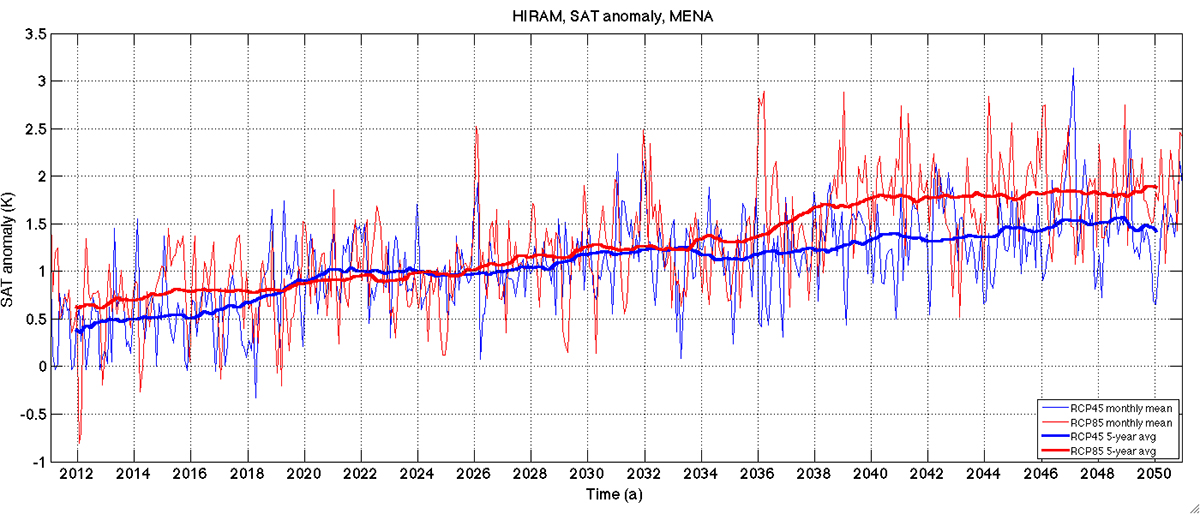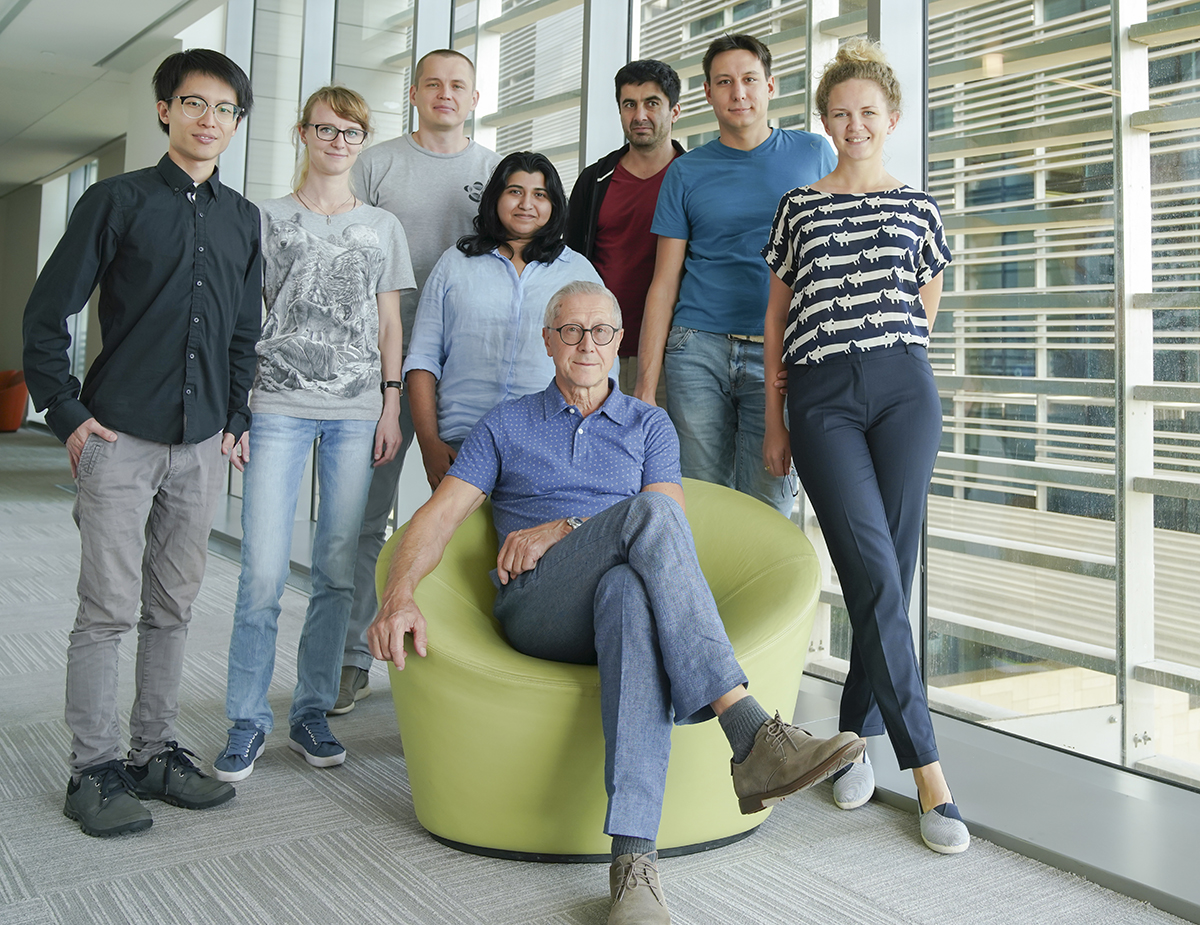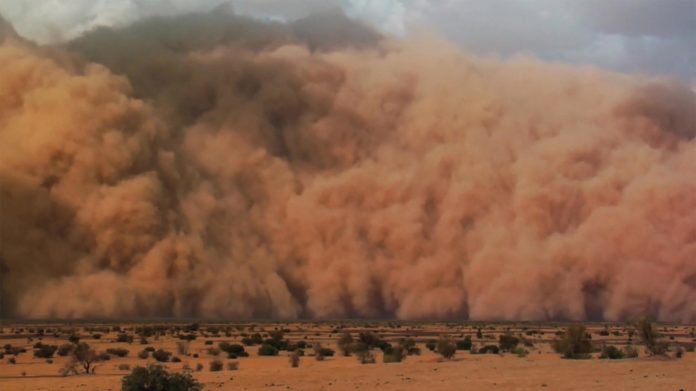Professor Georgiy Stenchikov, Chair of Earth Sciences and Engineering Program at King Abdullah University of Science and Technology (KAUST), explains how MENA accounts for more than half of global dust emissions, and the immense strain on the environment dust can cause
The consequences of climate change are complex, far-reaching, and are felt on global and regional scales. Climate projections on regional and local scales are essential for adaptation and planning on national and sub-national levels to increase resilience and robustness of industrial and social infrastructures. Adaptation on a regional scale is more feasible than on a global one, as proposed global geoengineering “solutions” such as solar radiation management could assure the planet cooling but cause adverse regional consequences. The MENA climate is especially vulnerable to these adverse effects.
Freshwater is the most vital resource in the desert environment. Management of water resources over MENA is challenging. Population growth, industries, and agricultural activities over the past century have led to an increase in demand for water supply. At the same time due to environmental conditions, per-capita freshwater consumption is high. For example, the Kingdom of Saudi Arabia (KSA) has one of the highest per-capita rates of water consumption (near 300t yr-1) in the world. The KSA desalinises about 1Gt of water per year producing 25-30% of all desalinated water in the world.
Precipitation Modification
The idea of artificially increasing the precipitation has attracted attention for many years. The United Arab Emirates are currently funding research on a rain enhancement program that explores different technical options. There were marginally successful attempts using cloud seeding to trigger rain processes in desert environments. The ways in which dusts can affect clouds and precipitation is not widely known or fully understood. Afforestation is a known way of increasing precipitation. Instead, we found that decreasing surface albedo by distributing solar panels over the Red Sea coastal plain enhances sea breezes and triggers more precipitation over that region. This method has little environmental consequence in the surrounding areas. It can be used as a climate adaptation measure and is an example of regional-scale precipitation geoengineering.

Temperature trend
The Middle East experiences an enhanced level of warming in comparison with the average warming trend over the Northern Hemisphere. One of the reasons is extreme dryness of the region that prevents the land surface energy balance adjustment by increasing evaporation. Therefore, the desert temperature sensitivity to radiative forcing, solar and longwave, is higher than that averaged over the global landmasses. The highest warming trend is observed in Summer making temperature extremes more severe. Fig. 1 shows the temperature projection in MENA until 2050 for two IPCC emission scenarios RCP8.5 (red, business as usual) and RCP4.5 (blue) with decreasing of CO2 emissions starting from 2030. This assessment was conducted for the United Nations Economic and Social Commission for Western Asia (UN ESCWA) project on water resources and social vulnerability in Arab countries. The projections were calculated on a KAUST supercomputer using the global high-resolution atmospheric model (HiRAM) with a regional spatial resolution of 25×25 km2. The results show steady warming for more than 1 K by the middle of the 21st century.
Regional climate predictions
Regional climate changes are driven by global climate trends. But predicting regional climate is more challenging than the global climate, as high spatial resolution is required, and natural variability, nonlinear circulation responses, and local physical effects complicate the analysis. Professor Stenchikov’s group at KAUST is focusing on the MENA region that is one of the most vulnerable to climate change. The MENA environmental characteristics are at the brink of livability, but global warming will be exacerbating impacts on health, infrastructure, human migration, biodiversity, tourism, and food production.
The current regional climate prediction technology is based on two pillars: Simulations with fine-resolution global models and downscaling Earth System Model outputs using nested regional models. The technology we are developing at KAUST is based on a combination of these two approaches, as we conduct a deep downscaling of the high-resolution global climate forecast using the regional atmospheric model. To add in physical consistency, we coupled the regional atmospheric model with the regional ocean model accounting for aerosol and atmospheric chemistry processes.

Global dust emissions
Along with Central and Eastern Asia, the MENA significantly contributes to global dust emissions, which are in the range of 1000–2000 Tg yr-1. MENA accounts for more than half of global dust emissions. Dust affects solar and terrestrial radiation, the planetary energy balance, atmospheric circulation. Dust produces the world’s largest solar radiative cooling reaching in the southern Red Sea 60 W/m2. The prolonged dryness and social conflicts led to the growth of dust aerosol optical depth (AOD) that characterises the radiative effect of aerosols (see Fig. 2). Dust deposition on the surfaces of solar panels inhibits their efficiency. However, absorption of UV radiation by dust diminishes the effect of UV on humans.
Dust radiative effect is complex as dust particles both reflect and absorb solar radiation, and generate a significant greenhouse warming. As a result, dust cools the surface but warms the atmosphere. The radiative effect of dust depends on the surface albedo and solar zenith angle. Atmospheric heating caused by Saharan dust alters both Hadley and Walker circulation moving the rain belt north in Summer increasing precipitation in Sahel. We found that the radiative cooling of the Southern Red Sea due to accumulated dust layers affects circulation and energy balance of the sea, the effect that was not previously recognised.
Dust is not the only aerosol in the Middle East. Anthropogenic aerosols are produced as a result of industrial activity, traffic, power generation are abundant, especially in the population centres. The aerosol’s mix, so cold particulate matter (PM) severely affects air quality. The dramatic increase in the level of air pollution in developing countries over the last decades is forced by rapid economic and population growth, burning of fossil fuels, construction and agricultural activities. Still, the primary cause of air pollution in the MENA is mineral dust, and it is on the rise (see Fig. 2). In KSA dust is responsible for about 95% of aerosol concentration. But in the cities, an anthropogenic aerosol component is coming on the top of dust significantly deteriorating the urban air quality. At almost all territory of the Arabian Peninsula PM pollution exceeds the World Health Organization (WHO) limits.
Climate models allow us to understand the physical mechanisms of climate variability and estimate future climate changes. But models alone are not sufficient to make reliable estimates. The model parameter identification and testing require accurate observations of environmental characteristics, especially, associated with aerosols.

KAUST Dust monitoring
Professor Stenchikov has established a comprehensive aerosol monitoring research at KAUST campus. The KAUST AERONET site has been operational for almost a decade providing multi-wavelength observations of column integrated aerosol optical depth, aerosol size distribution, Angstrom exponent, and refractive index. A micro-pulse lidar measures vertical distribution of aerosol backscattering coefficient. We developed a new retrieval algorithm that allowed us to obtain vertical distribution of aerosol extinction, single scattering albedo, and aerosol mixing ratio. We were the first who conducted systematic measurements of aerosol optical depth over the Rea Sea using a hand-held sunphotometer (MICROTOPS). These measurements are conducted in cooperation with the NASA Goddard Space Flight Center and observations are accessible at the NASA website within AERONET, MPLnet, and MARITIME archives. We also conducted a multi-year campaign on measuring aerosol deposition rate and conducted mineralogical and size distribution analysis of deposition samples. This is meant to help predict the dust health effect, its radiative properties, and provide the means to test dust mass balance.
The combination of advanced modelling with the integrated results of environmental monitoring is a proven approach to advance regional climate forecast for MENA to inform environmental decision making. There is a lot that must be understood regarding the effect of dust in the desert environment. For example, dust chemically and microphysically interacts with anthropogenic pollutants e.g. sulphate aerosols, that changes dust radiative effect and life cycle. The comprehensive climate models allow integrating empirical data with physical mechanisms and are invaluable for understanding complex climate processes. These models could be used for assessment of the efficacy of adaptation and mitigation measures, and are instrumental in evaluating and mapping renewable energy resources.
Related Group’s Publications
Kalenderski, S., Stenchikov, G., & Zhao, C. (2013). Modeling a typical winter-time dust event over the Arabian Peninsula and the Red Sea. Atmospheric Chemistry and Physics, 13(4), 1999-2014. DOI: 10.5194/acp-13-1999-2013
Bangalath, H. K., & Stenchikov, G. (2015). Role of dust direct radiative effect on the tropical rain belt over Middle East and North Africa: A high-resolution AGCM study. Journal of Geophysical Research: Atmospheres, 120(10), 4564-4584. DOI: 10.1002/2015JD023122
Brindley, H., Osipov, S., Bantges, R., Smirnov, A., Banks, J., Levy, R., Jish Prakash, P., & Stenchikov, G. (2015). An assessment of the quality of aerosol retrievals over the Red Sea and evaluation of the climatological cloud-free dust direct radiative effect in the region. Journal of Geophysical Research: Atmospheres, 120(20), 10,862-810,878. DOI: 10.1002/2015jd023282
Deng, L., McCabe, M. F., Stenchikov, G., Evans, J. P., & Kucera, P. A. (2015). Simulation of Flash-Flood-Producing Storm Events in Saudi Arabia Using the Weather Research and Forecasting Model. Journal of Hydrometeorology, 16(2), 615-630. DOI: 10.1175/jhm-d-14-0126.1
Farley Nicholls, J., Toumi, R., & Stenchikov, G. (2015). Effects of unsteady mountain-gap winds on eddies in the Red Sea. Atmospheric Science Letters, 16(3), 279-284. DOI: 10.1002/asl2.554
Khan, B., Stenchikov, G., Weinzierl, B., Kalenderski, S., & Osipov, S. (2015). Dust plume formation in the free troposphere and aerosol size distribution during the Saharan Mineral Dust Experiment in North Africa. Tellus B: Chemical and Physical Meteorology, 67(1), 27170. DOI: 10.3402/tellusb.v67.27170
Lelieveld, J., Beirle, S., Hörmann, C., Stenchikov, G., & Wagner, T. (2015). Abrupt recent trend changes in atmospheric nitrogen dioxide over the Middle East. Science Advances, 1(7), e1500498. DOI: 10.1126/sciadv.1500498
Osipov, S., Stenchikov, G., Brindley, H., & Banks, J. (2015). Diurnal cycle of the dust instantaneous direct radiative forcing over the Arabian Peninsula. Atmospheric Chemistry and Physics, 15(16), 9537-9553. DOI: 10.5194/acp-15-9537-2015
Prakash, J., Stenchikov, G., Kalenderski, S., Osipov, S., & Bangalath, H. (2015). The impact of dust storms on the Arabian Peninsula and the Red Sea. Atmospheric Chemistry and Physics, 15(1), 199-222. DOI: 10.5194/acp-15-199-2015
Kalenderski, S., & Stenchikov, G. (2016). High-resolution regional modeling of summertime transport and impact of African dust over the Red Sea and Arabian Peninsula. Journal of Geophysical Research: Atmospheres, 121(11), 6435-6458. DOI: 10.1002/2015jd024480
Klingmüller, K., Pozzer, A., Metzger, S., Stenchikov, G. L., & Lelieveld, J. (2016). Aerosol optical depth trend over the Middle East. Atmospheric Chemistry and Physics, 16(8), 5063-5073. DOI: 10.5194/acp-16-5063-2016
Prakash, J., Stenchikov, G., Tao, W., Yapici, T., Warsama, B., & Engelbrecht, J. P. (2016). Arabian Red Sea coastal soils as potential mineral dust sources. Atmospheric Chemistry and Physics, 16(18), 11991-12004. DOI: 10.5194/acp-16-11991-2016
Yip, C. M. A., Gunturu, U. B., & Stenchikov, G. L. (2016). Wind resource characterization in the Arabian Peninsula. Applied Energy, 164, 826-836. DOI: 10.1016/j.apenergy.2015.11.074
Zolina, O., Dufour, A., Gulev, S. K., & Stenchikov, G. (2016). Regional Hydrological Cycle over the Red Sea in ERA-Interim. Journal of Hydrometeorology, 18(1), 65-83. DOI: 10.1175/jhm-d-16-0048.1
Abdelkader, M., Metzger, S., Steil, B., Klingmüller, K., Tost, H., Pozzer, A., Stenchikov, G., Barrie, L., & Lelieveld, J. (2017). Sensitivity of transatlantic dust transport to chemical aging and related atmospheric processes. Atmospheric Chemistry and Physics, 17(6), 3799-3821. DOI: 10.5194/acp-17-3799-2017
Anisimov, A., Tao, W., Stenchikov, G., Kalenderski, S., Prakash, P. J., Yang, Z. L., & Shi, M. (2017). Quantifying local-scale dust emission from the Arabian Red Sea coastal plain. Atmospheric Chemistry and Physics, 17(2), 993-1015. DOI: 10.5194/acp-17-993-2017
Banks, J. R., Brindley, H. E., Stenchikov, G., & Schepanski, K. (2017). Satellite retrievals of dust aerosol over the Red Sea and the Persian Gulf (2005–2015). Atmospheric Chemistry and Physics, 17(6), 3987-4003. DOI: 10.5194/acp-17-3987-2017
Cahill, B., Toumi, R., Stenchikov, G., Osipov, S., & Brindley, H. (2017). Evaluation of thermal and dynamic impacts of summer dust aerosols on the Red Sea. Journal of Geophysical Research: Oceans, 122(2), 1325-1346. DOI: 10.1002/2016jc011911
El-Samra, R., Bou-Zeid, E., Bangalath, H. K., Stenchikov, G., & El-Fadel, M. (2017). Future intensification of hydro-meteorological extremes: downscaling using the weather research and forecasting model. Climate Dynamics, 49(11), 3765-3785. DOI: 10.1007/s00382-017-3542-z
Engelbrecht, J. P., Stenchikov, G., Prakash, P. J., Lersch, T., Anisimov, A., & Shevchenko, I. (2017). Physical and chemical properties of deposited airborne particulates over the Arabian Red Sea coastal plain. Atmospheric Chemistry and Physics, 17(18), 11467-11490. DOI: 10.5194/acp-17-11467-2017
Osipov, S., & Stenchikov, G. (2017). Regional Effects of the Mount Pinatubo Eruption on the Middle East and the Red Sea. Journal of Geophysical Research: Oceans, 122(11), 8894-8912. DOI: 10.1002/2017jc013182
Yip, C. M. A., Gunturu, U. B., & Stenchikov, G. L. (2017). High-altitude wind resources in the Middle East. Scientific Reports, 7(1), 9885. DOI: 10.1038/s41598-017-10130-6
Anisimov, A., Axisa, D., Kucera, P. A., Mostamandi, S., & Stenchikov, G. (2018). Observations and Cloud-Resolving Modeling of Haboob Dust Storms Over the Arabian Peninsula. Journal of Geophysical Research: Atmospheres, 123(21), 12,147-112,179. DOI: 10.1029/2018jd028486
El-Samra, R., Bou-Zeid, E., Bangalath, H. K., Stenchikov, G., & El-Fadel, M. (2018). Seasonal and Regional Patterns of Future Temperature Extremes: High-Resolution Dynamic Downscaling Over a Complex Terrain. Journal of Geophysical Research: Atmospheres, 123(13), 6669-6689. DOI: 10.1029/2017jd027500
Klingmüller, K., Metzger, S., Abdelkader, M., Karydis, V. A., Stenchikov, G. L., Pozzer, A., & Lelieveld, J. (2018). Revised mineral dust emissions in the atmospheric chemistry–climate model EMAC (MESSy 2.52 DU_Astitha1 KKDU2017 patch). Geoscientific Model Development, 11(3), 989-1008. DOI: 10.5194/gmd-11-989-2018
Osipov, S., & Stenchikov, G. (2018). Simulating the Regional Impact of Dust on the Middle East Climate and the Red Sea. Journal of Geophysical Research: Oceans, 123(2), 1032-1047. DOI: 10.1002/2017jc013335
Klingmüller, K., Lelieveld, J., Karydis, V. A., & Stenchikov, G. L. (2019). Direct radiative effect of dust–pollution interactions. Atmospheric Chemistry and Physics, 19(11), 7397-7408. DOI: 10.5194/acp-19-7397-2019
Parajuli, S. P., Stenchikov, G. L., Ukhov, A., & Kim, H. (2019). Dust Emission Modeling Using a New High-Resolution Dust Source Function in WRF-Chem With Implications for Air Quality. Journal of Geophysical Research: Atmospheres, 124(17-18), 10109-10133. DOI: 10.1029/2019jd030248
Raj, J., Bangalath, H. K., & Stenchikov, G. (2019). West African Monsoon: current state and future projections in a high-resolution AGCM. Climate Dynamics, 52(11), 6441-6461. DOI: 10.1007/s00382-018-4522-7
Klingmüller, K., Karydis, V. A., Bacer, S., Stenchikov, G. L., & Lelieveld, J. (2020). Weaker cooling by aerosols due to dust-pollution interactions. Atmos. Chem. Phys., 20, 15285–15295, https://doi.org/10.5194/acp-20-15285-2020
Ukhov, A., Mostamandi, S., Krotkov, N., Flemming, J., da Silva, A., Li, C., Fioletov, V., McLinden, C., Anisimov, A., Alshehri, Y. M., & Stenchikov, G. (2020). Study of SO2 Pollution in the Middle East Using MERRA-2, CAMS Data Assimilation Products, and High-Resolution WRF-Chem Simulations. Journal of Geophysical Research: Atmospheres, 125(6), e2019JD031993. DOI: 10.1029/2019jd031993
Ukhov, A., Mostamandi, S., da Silva, A., Flemming, J., Alshehri, Y., Shevchenko, I., & Stenchikov, G. (2020). Assessment of natural and anthropogenic aerosol air pollution in the Middle East using MERRA-2, CAMS data assimilation products, and high-resolution WRF-Chem model simulations. Atmospheric Chemistry and Physics, 20(15), 9281-9310. DOI: 10.5194/acp-20-9281-2020
Parajuli, S. P., Stenchikov, G. L., Ukhov, A., Shevchenko, I., Dubovik, O., and Lopatin, A. (2020). Interaction of Dust Aerosols with Land/Sea Breezes over the Eastern Coast of the Red Sea from LIDAR Data and High-resolution WRF-Chem Simulations, Atmos. Chem. Phys. 20, 16089-16116, https://doi.org/10.5194/acp-16089-2020
Lopatin, A., Dubovik, O., Fuertes, D., Stenchikov, G., Lapyonok, T., Veselovskii, I., Wienhold, F. G., Shevchenko, I., Hu, Q., and Parajuli, S. (2020). Synergy processing of diverse ground-based remote sensing and in situ data using GRASP algorithm: applications to radiometer, lidar and radiosonde observations, Atmos. Meas. Tech. Discuss., https://doi.org/10.5194/amt-2020-422
Please note: This is a commercial profile











